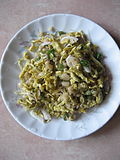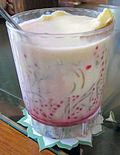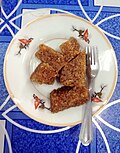
The Karen, also known as the Kayin, Kariang or Kawthoolese, are an ethnolinguistic group of Tibeto-Burman language-speaking people. The group as a whole is heterogeneous and disparate as many Karen ethnic groups do not associate or identify with each other culturally or linguistically. These Karen groups reside primarily in Kayin State, southern and southeastern Myanmar. The Karen account for around 6.69% of the Burmese population. Many Karen have migrated to Thailand, having settled mostly on the Myanmar–Thailand border. A few Karen have settled in the Andaman and Nicobar Islands, India, and other Southeast Asian and East Asian countries.

Green papaya salad is a spicy salad made from shredded unripe papaya. It is generally believed to have been created by the Lao people and is considered one of the national dishes of Laos. Green papaya salad is also popular in neighbouring Thailand's Isan region, whose population is mainly composed of ethnic Lao and from where it spread to the rest of Thailand. Green papaya salad has also spread to the rest of the continental Southeast Asia, as well as Xishuangbanna (China).

Burmese cuisine encompasses the diverse regional culinary traditions of Myanmar, which have developed through longstanding agricultural practices, centuries of sociopolitical and economic change, and cross-cultural contact and trade with neighboring countries at the confluence of Southeast Asia, East Asia, and South Asia, such as modern-day nations of Thailand, China, and India, respectively. Mohinga, a savory fish soup with lemongrass and banana leaves are eaten for breakfast with rice noodles, lunch is rice accompanied with small side dishes of vegetables, a small soup and a meat or fish dish. Dinner is consumed in a similar fashion to lunch. Burmese stews or curries are not Indian curries but milder with reliance on the trio of onion garlic and ginger to create savory gravies. Burmese food does not rely heavily on coconut such as in Thai cuisine. Burmese however enjoy spicy food with addition of chilis mixed into the dishes.
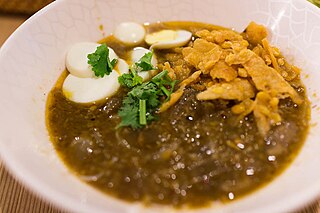
Mohinga is the national dish of Myanmar. Mohinga is fish soup made with rice noodles, typically served as a hearty breakfast. It features a rich broth flavored with lemongrass, turmeric, and fish sauce, often garnished with boiled eggs, cilantro, and crispy fritters. Mohinga is readily available in most parts of the country, sold by street hawkers and roadside stalls in larger cities. Mohinga is traditionally eaten for breakfast, but today is eaten at any time of day. Egg, onions or herbs can be added into the dish.
Naga cuisine is the traditional foods of the Naga people in the northeastern region of India and Kachin, Sagaing Region of Myanmar. Each ethnic group of the Nagas prepares its own unique style of cuisines. It most notably features rice, meats and leaf vegetables. Meat prepared by the Nagas are often smoked, dried or fermented. Naga dishes are quite similar to dishes of Southeast Asian countries like Myanmar and Thailand.

Ngapi is a pungent paste made of either fish or shrimp used in Burmese cuisine. Ngapi is typically made by fermenting fish or shrimp that is salted and ground then sundried. Like cheese, it can be distinguished based on main ingredient and regional origin. Ngapi can be distinguished by the type of fish used to make it. Ngapi can come from whole fish, from small fish or from prawns. Ngapi is a main ingredient of Lower Burmese cooking and is used as a condiment or additive in most dishes. Raw ngapi, with some exceptions, is not intended for direct consumption.
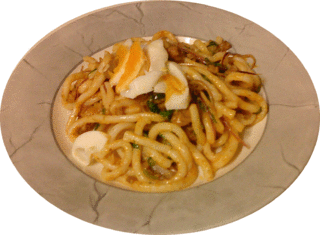
Nan gyi thoke is an a thoke salad dish in Burmese cuisine, made with thick round rice noodles mixed with specially prepared chicken curry and chili oil. The dish is garnished with toasted chickpea flour, sliced onions, chilis, crispy noodles, slices of hard-boiled egg, fish cakes, and zested with lime or lemon. The noodle salad originated as a street food from Mandalay.

Bamboo shoots or bamboo sprouts are the edible shoots of many bamboo species including Bambusa vulgaris and Phyllostachys edulis. They are used as vegetables in numerous Asian dishes and broths. They are sold in various processed shapes and are available in fresh, dried, and canned versions.

The cuisine of Mauritius is greatly influenced by the tropical location of the island as well as the cultural diversity which characterizes the country. Mauritian cuisine is a blend of African, Chinese, European and Indian influences in the history of Mauritius. Most of the dishes and culinary traditions are inspired by French culture, former African slaves, Indian workers and Chinese migrants that arrived in the country during the 19th century. Over the years, communities found in Mauritius have adapted and mixed each other's cuisine to their liking, resulting in the development of Mauritian cuisine. While some popular dishes and desserts are consumed by Mauritians of all ethnic groups or communities, there are also forms of cuisines which remain unique to a specific ethnic community due to their ancestral cultural and historical connections. Local food therefore reflects the strong traditional, cultural, and historical influences of each community. French cuisine and Sino-Mauritian cuisine are very popular in Mauritius.

Burmese salads are a diverse category of indigenous salads in Burmese cuisine. Burmese salads are made of cooked and raw ingredients that are mixed by hand to combine and balance a wide-ranging array of flavors and textures. Burmese salads are eaten as standalone snacks, as side dishes paired with Burmese curries, and as entrees. The most common or popular, the iconic laphet thoke is traditionally eaten as a palate cleanser at the end of a meal.

Sigyet khauk swe is a fried noodle dish in Burmese cuisine. Egg or wheat noodles are fried in sigyet, fried garlic, topped with a protein like duck or roast duck, and optionally garnished with sliced cucumbers and green onions. The dish is associated with the Sino-Burmese community.

Sanwin makin is a traditional Burmese dessert or mont, popularly served during traditional donation feasts, satuditha feasts, and as a street snack. The dessert bears resemblance to desserts in neighboring India, where it is called sooji halwa, and Thailand, where it is called khanom mo kaeng.

Poe Ei Ei Khant is a Burmese actress. She is best known for her leading roles in several Burmese films. Throughout her career, she has acted in over 100 films.

Mg Mg Aye is a Burmese television host and MC. He has been the host for several Burmese TV programs and received acceptance of audience for the reality game show Puzzle Palace. Mg Mg Aye was a judge on Myanmar's Got Talent. He is the founder of Myanmar's first entertainment and game company, Dream Boat Entertainment. Mg Mg Aye is also active as a philanthropist with the notable charitable organization We Love Yangon.

Burmese curry refers to a diverse array of dishes in Burmese cuisine that consist of protein or vegetables simmered or stewed in an aromatic curry base. Burmese curries generally differ from other Southeast Asian curries in that Burmese curries make use of dried spices in addition to fresh herbs and aromatics, and are often milder. Burmese curries are readily available in curry houses throughout the country. They are traditionally accompanied with rice and a variety of side dishes, soups, and Burmese salads called athoke. Burmese curries may also be paired with Indian breads like nanbya, palata, aloo puri, and toshay.
Tu Hnine Ma Ya Tae Myittar is a 2021 Burmese drama television series. It aired on MRTV-4, from March 8 to April 15, 2021, on Mondays to Fridays at 19:00 for 29 episodes.

A Mhya..A Mhya... is a 2019 Burmese horror drama film, directed by Steel starring Khant Si Thu, Eaindra Kyaw Zin and Lin Zarni Zaw. It was produced by R Square Films and premiered in Myanmar on October 3, 2019.
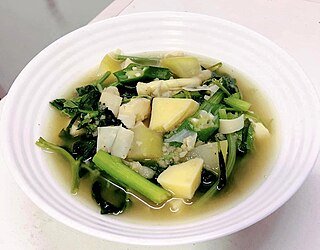
Talabaw, is a soup that originated in Karen cuisine. It is typically prepared with bamboo shoots, snakehead fish and basil leaves. A small amount of rice and some shreds of meat or seafood may also be added.
Thinzar is a Burmese actress and model. She rose to fame after debuting in the 2022 TV drama Trapped. She is the younger sister of actress, Warso Moe Oo.




